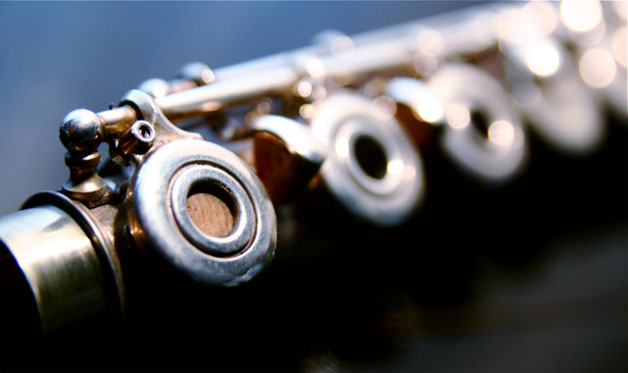Improve your Sax Playing – with Flute Exercises!
 I’m always on the lookout for exercises that develop tone, technique and articulation. While I use material that is familiar to saxophonists (e.g. The Universal Method, Oliver Nelson’s Patterns for Saxophone), I also draw from methods developed for other instruments. Having started as a classical flute player (until a Charlie Parker record changed my life), I routinely use some of the classic flute methods to improve my saxophone skills.
I’m always on the lookout for exercises that develop tone, technique and articulation. While I use material that is familiar to saxophonists (e.g. The Universal Method, Oliver Nelson’s Patterns for Saxophone), I also draw from methods developed for other instruments. Having started as a classical flute player (until a Charlie Parker record changed my life), I routinely use some of the classic flute methods to improve my saxophone skills.
Tone
The gold standard for flute tone development is Marcel Moyse’s De La Sonorité. It begins with an exercise that I use on all of my horns to work on tone and intonation. The exercise itself looks simple. Starting with a quarter note on high B, you slur down to a dotted half note on Bb. The idea is that it is relatively easy to get a nice tone on high B on the flute. Once the tone and intonation of the high B is secure, you try to bring that same quality to the Bb. Since you are only moving a half step, it is relatively easy to match the quality of the two notes. Moyse suggests one repeat of the pair of notes. I repeat the pair at 60 bpm on the metronome until I’m satisfied with the tone and pitch of both notes. The exercise continues chromatically (Bb to A, A to Ab, etc.) all the way to bottom of the flute. At each point, you are trying to match the tone and pitch with the previous note.
Along the way, you will discover which notes on your horn require special attention—for example, middle C# is usually problematic on both flute and sax. In addition to using the metronome, I have my tuner on as well. I don’t watch the tuner constantly. Instead, I play with my eyes closed, listening intently. When I’m happy with the tone and intonation of the second note, I’ll glance at the tuner to confirm that I’m in tune.
Finally, for doublers, this exercise is great to keep your chops up on all your horns. I will play 4 measures on flute, followed by 4 measures on alto, followed by 4 on clarinet, etc. The challenge is to match the tone quality and intonation as you switch among horns. If you’re looking for a real challenge, switch between piccolo and soprano sax. That is a real workout – although your neighbors may not enjoy it!
Technique
Moyse wrote another book entitled, Gammes et Arpèges, although many flutists just refer to it as the 480 (or Moyse’s 480). They are 480 exercises based on scales and arpeggios. They will take you through all keys and all around the horn. As a saxophonist, you can either truncate the exercises when the range gets too high or take the opportunity to work on your altissimo technique.
Another classic technique builder is the 17 Daily Exercises of Paul Taffanel and Phillipe Gaubert. Exercise 1 just takes the first five notes of the major scale and gradually ascends through the keys. There are 10 suggested articulations to be used, so you can work on your articulation while building your technique. Exercise 2 is similar, only using the minor scale. Exercise 4 is a classic that works its way through all major and minor scales. This is another one that I like to play on multiple horns. I will play through the whole exercise on flute, then switch to alto, then whatever other horns I’m trying to keep in shape.
Another great exercise is Daily Study #2 from Reichert’s 7 Daily Exercises. It explores the dominant to tonic resolution of arpeggios in all inversions and moves through all 24 major and minor keys. I like to practice this exercise at two extremes on the metronome. At 40 bpm, I use it as a tone development exercise and work on bringing out the different tone colors of the different keys. At 240 bpm, I use it to develop fluidity in all keys. It makes a great warmup exercise as well.
Articulation
Rather than practice separate articulation studies, I tend to use the technique exercises cited above with different articulations (killing two birds with one stone). The Taffanel and Gaubert exercises have 10 suggested articulations which I use with those exercises as well as the Reichert, etc. Articulation #1 is all-slurred which I good for finding unevenness in your fingers. Articulation #10 is all-tongued which is great for building tonguing endurance. The others mix tonguing and slurring in interesting ways. Some sound distinctly classical to my ears, while others (with the right accents) sound like articulations that Sonny Rollins or Cannonball have used.
Although the focus of this article has been on using flute exercises, I’m not averse to stealing from the clarinet repertoire as well! Clarinetist Robert Spring has an impressive video on YouTube dealing with warming up. Starting at about 6 minutes into the video, he discusses his articulation work based on an exercise by Langenus. Watch as he repeats the exercise faster and faster and moves from single to double to triple tonguing.
You can contact Dr. Spring at rspring@asu.edu and ask him to send you “The Packet”. It contains the music he’s playing and also some introductory comments. One of the comments really struck me:
“I have found that during the 25 years that I have been working on this exercise, my tongue speed and accuracy have gone beyond my wildest dreams.”
Think about that for a minute. 25 YEARS working on an exercise! How often do we (myself included) jump from one thing to another without taking the time to really dig into an exercise? Imagine the benefits to be gained from consistent daily practice of a small set of exercises.
Summary
I hope this article has presented a few new sources for developing your tone, technique, and articulation on all of your horns. Check out the suggested flute exercises but look for other ideas from the clarinet, oboe, and bassoon literature as well.
About Jeff Rzepiela
Jeff Rzepiela is a multi-instrumentalist and arranger working in the Bay Area. His website (www.scooby-sax.com) features a large collection of transcriptions from the masters of the saxophone. Additionally, there are several free lessons on the website based on ideas drawn from these transcriptions. Jeff is available for lessons either in person or via Skype. Contact him at scooby@scooby-sax.com.






May 16, 2011 @ 6:51 am
+1 on using the Taffanel/Gaubert on saxophone. I like those especially for working out awkwardness up in the palm keys and down in the LH table.
I also like to use the “68 Exercises of Mechanism” from the Klosé clarinet method on multiple instruments (I believe the Universal Method for saxophone has an appropriately-transposed version of these).
August 6, 2011 @ 3:59 pm
Interesting. I currently use Klose, Viola Technique of the Saxophone, and Universal Method for sax, Langenus Method for clarinet, Oppermann Velocity Studies for bass clarinet, and Wye Daily Studies for flute. I’ve often wondered about whether my technique would improve or suffer if I say took one exercise at a time out of one of these books and practiced it on all instruments and practiced like that.
However I don’t know of anyone who does this. People seem to use sax books for sax, clarinet for clarinet, and flute for flute.
August 6, 2011 @ 5:34 pm
Hello Ken,
I can’t imagine how using any one of these books could degrade your technique on any instrument. Sounds like you hav a great regimen going with all of your books!
Doron
January 9, 2012 @ 3:28 pm
Reading this reminded me that I read how Branford Marsalis did this as well. I may have to check this out.
May 28, 2013 @ 7:37 am
i use taffanael & gaubert, m.moyse, georges barre and teleman. they are all very gifted at pedagogy in the etude.
their etudes work over the 3 flute octaves. I am not a saxist who play 2 and a half. I need the 3 span or more.
I need the upper ledgers. they will take you up 5 ledgers.
Carnival of Venice [Rascher] needs more.
At any rate the French School , for both fl and sax ,is very nice.
Sax etude bks are range limited. Cater for the majority.
j frankie springer may 2013. (alto)
Switching from the Saxophone to the Flute
September 9, 2020 @ 1:13 pm
[…] flute will be a lot simpler to get into than many other instruments, but it will also force you to develop skills you may have never practiced before. It will also open up a lot of new melodic possibilities and […]